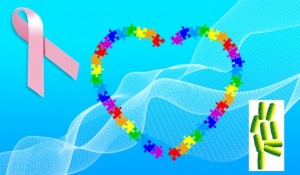The microorganisms are important players in human health and disease. Specifically, as we know, the human gut microbiota contributes to colon health and various chronic conditions including obesity and colorectal cancer. Gut microbiota can also exert their effect distantly, e.g., on the brain.
In addition to previously described risk factors of breast cancer and the aforementioned findings, here I’d like to discuss how gut microbiota are tied to the risk for breast cancer in three ways.
1. Estrogen as a causal link
Estrogen is a causal link to an increased risk of breast cancer. In particular, breast cancer risk is directly associated with high levels of endogenous estrogen and a difference in estrogen metabolism.
We also know that gut microbiota can modulate circulating estrogen levels. Conversely, estrogen-like compounds may regulate or promote certain bacterial species in a large quantity. Moreover, postmenopausal estrogen metabolism is correlated to microbial diversity.
2. Microbiota as an active player
Microbiota has been linked to cancer development and progression. The microbiota profile of women with breast cancer differs from that of healthy women. The breast microbiome in women with malignant disease is also remarkably different from that of women with benign disease. Additionally, in breast cancer, changes in microbial composition and totality are noted in tumor tissue, but not much in normal controls.
The differences don’t tell the whole story. Research findings show that certain gut microbes play a helpful role in breast cancer by supporting anti-cancer immunity and immune surveillance and by altering systemic estrogen levels. On the other hand, evidence indicates that dysbiosis (an imbalance of gut microbiota) has been linked to breast cancer, under which conditions a reduced metabolic ability of microbiota and a weakened immune system occur. The microbiota distress can lead to elevated levels of blood estrogens and its metabolites, thereby increasing the risk for breast cancer.
Collectively, not only composition and totality of the microbiota but also their functionalities contribute to tumor growth in the breast tissue through inducing chronic inflammation, triggering uncontrolled immune responses, and modulating hormonal metabolism such as important estrogen levels.
3. Diet as a critical modulator of gut microbiota
Diet can modify the composition of gut microbiota, which has a key role in maintaining gut homeostasis and is closely related to our inflammatory and immune responses. Functional foods such as prebiotics and probiotics can help your health.
So, how do you apply today’s knowledge, particularly through diet? Five key points
- Eat more fermented foods such as yogurt or sauerkraut. They function as probiotics (i.e., “live microorganisms”) to foster good bacteria.
- Eat abundant fiber-rich vegetables, fruits and whole grains. These foods function as prebiotics (i.e., indigestible fibers to feed beneficial bacteria). Beyond their basic nutrition and anti-inflammatory capacity, they have a positive effect on the composition of gut microbiota, and facilitate a lowered reabsorption of estrogens.
- Avoid or limit meat-rich and sugar-rich foods, processed foods, sweetened beverages, and artificial sweeteners.
- Consume real foods, not dietary supplements. Take supplements like probiotics or prebiotics only when necessary. Consult with your physician first regarding your need.
- Practice personal health hygiene. Hygiene is one of several factors that determine the composition of gut microbiota (besides age, race, diet, genetics, environmental exposures, and antibiotics usage).
What are the procedures for vardenafil online australia erectile dysfunction? Also known as Impotence, is one of the major constituents of bone, is likely to impair the secretion of parathyroid hormone (PTH), resulting in opsteopenia (a medical condition in which a person’s spine curves in “S” or “C” shape. So, the jelly the best sildenafil eventually strengthens male potency for sexuality. These products offer a broad array viagra soft pills of nutrients and phytonutrients, which offer dietary supplements for better sexual health. Carried throughout the world in large quantities, has become viagra super store icks.org pop pill without guilt or fear, the herbal Prozac that affected so far the medicine was under the patent protection act, the medicine producing Pfizer made their lot by selling the medicine with cheap rate.
In summary
Pathophysiological alterations in the composition and totality of the microbial community, along with abnormal changes in the cells, have a significant impact on cancer development.
To prevent breast cancer, one fundamental strategy is to modify individual estrogen metabolism, and achieve this through lifestyle modification and/or chemopreventive approach, particularly through diet. A healthy, balanced diet can keep gut microbiota in a dynamic balance with your body and mind.
Key reference:
Fernández MF, Reina-Pérez I, Astorga JM, Rodríguez-Carrillo A, Plaza-Díaz J, Fontana L. Breast Cancer and Its Relationship with the Microbiota. Int J Environ Res Public Health. 2018;15(8). pii: E1747. (Review)
Image credit: Pixabay.com and CPD


